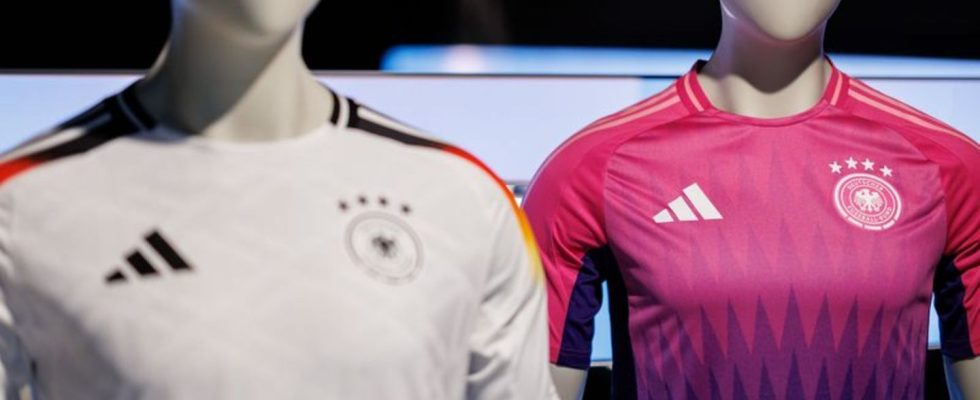Barbie wears it, Lionel Messi does the same, and now the DFB team also wears it: the color pink. Hardly any nuance evokes more emotions. Because it’s also about masculinity, ideology and zeitgeist.
The lawn premiere in pink and purple has already been a success. What would have been going on on social media if the German soccer men in the much-discussed new European Championship jersey had not won against the Netherlands on Tuesday evening? Because in the previous days, the whispering corners of the internet were partly conjuring up the downfall of masculinity because of the DFB team’s gaudy outfit.
Because one thing is clear: unlike ocher, beige or azure blue, pink is also a political issue. Color often opens a battlefield over ideology and gender. The dualism of pink for girls and light blue for boys has been established for decades. At the same time, supposed properties have also been given a coat of color: gentleness and strength.
What exactly is pink? What pink?
Pink is a bright color mixed from red and white. When expressions like rose red or rosy no longer seemed to reflect the delicate red color in the second half of the 18th century, pink came into German, borrowed from the Latin word for rose.
Pink has only been listed in German dictionaries since the 1980s. “Back then, bright, strong colors from Americanized pop culture were reflected in the German language,” says Niels Holger Wien. As Head of Colors at the German Fashion Institute (DMI), he is responsible for analyzing trends in society’s perception of color.
While pink in English (originated from the word for carnation, English: “pink”) stands for all colors in the pink spectrum, in German it describes “a dark, saturated, bright, bluish pink, for which the English do not have their own word “, writes the Berlin linguist Anatol Stefanowitsch on his blog. In short: Everything that is pink is pink – but not everything that is pink is pink.
Pink debate as a political issue
But no matter what the exact definition of a color is: Some people are triggered by both pink and pink, and in this context disapprove of pandering to an alleged zeitgeist that supposedly wants to blur gender boundaries. Some people even give vent to their hatred of the stereotypes that they associate with pink.
For color researcher Axel Buether, men who wear pink are “to some extent simply interested in an open society” and “a communicative and friendly attitude.” DMI expert Vienna explains in an interview with the German Press Agency about the pink debate: “For me, the excitement has a political dimension and a lot to do with discrimination against minorities.”
People have been surfing the pink wave for years
Strong pink, soft pink and everything in between have long been seen on catwalks and on trend-conscious fashionistas. With the very bright and softly warm shade “Millennial Pink” appearing around 2016, pink is becoming a gender-neutral color in Vienna’s opinion: men discovered it for themselves just as women did. “This millennial pink is perhaps also the reason for more acceptance of this entire color range,” he says. It calls into question a toxic masculinity.
In 2023, the Pantone Institute, which announces the trend color every year, is choosing the intense, pulsating tone “Viva Magenta”. When the “Barbie” film caused a sensation later in the year, the pink wave was hard to stop.
In any case, such jerseys are nothing new in men’s football. Juventus Turin first appeared in pink in 1898, before the Italians’ design changed to the legendary black and white stripes. And the Argentine superstar Lionel Messi currently wears the pink shade “Pantone 1895C” on match days for the US club Inter Miami. The New York Times calls the jersey “the hottest piece of sportswear on the planet” in fall 2023. The new DFB shirt is “fully in line with the spirit of the times,” says Vienna.
Male, female, universal
Pink and pink are associated by many with softness or delicacy. Colors were therefore “a no-go for a long time” in sports, says color researcher Buether. Barbie dolls, unicorns and princesses have long been decorated in such tones. Boys who are enthusiastic about this are often bullied at school.
In the past, pink was reserved for male offspring. Before it became possible synthetically around 1880, colors had to be produced from natural pigments in a complex and expensive manner. That’s why those in power in particular wore bright shades of red and their male offspring, i.e. future rulers, wore pink.
The fact that the color was also associated with homosexuality in the 20th century probably stems from the Nazis’ persecution of gays. In the Nazi concentration camps, homosexuals had to wear a pink chevron on their prisoner clothing as a symbol of identification. Many died.
The lists of men who were suspected of forbidden homosexuality, which had already been drawn up in the German Empire, were given the popular name Pink Lists over the years.
For the color expert in Vienna, the pink and light blue cliché for girls and boys is outdated in a society that is open to different groups and relationships. “No color, no matter what shade, is assigned to any gender or any person,” he sums up. “All colors are universal.”

